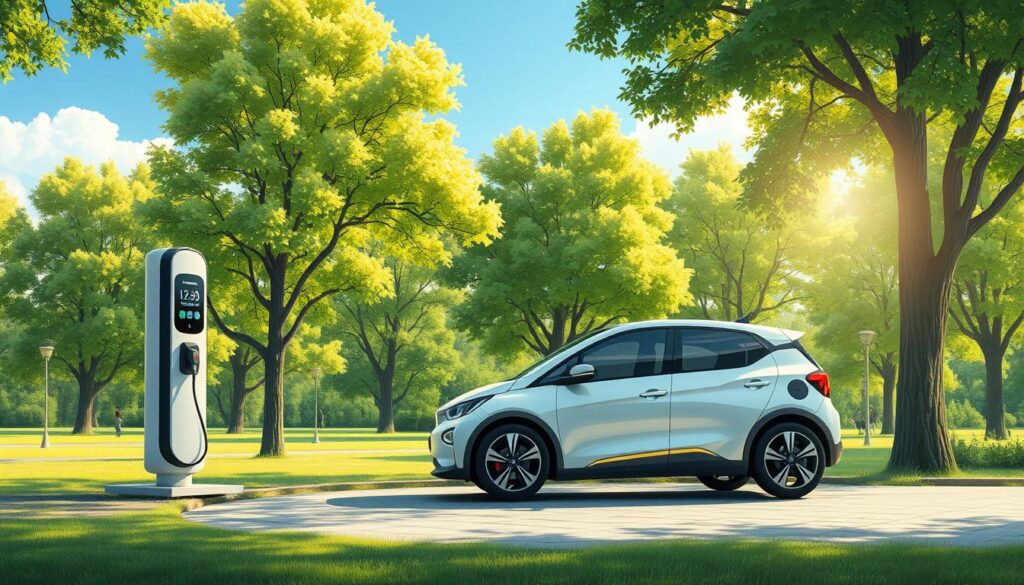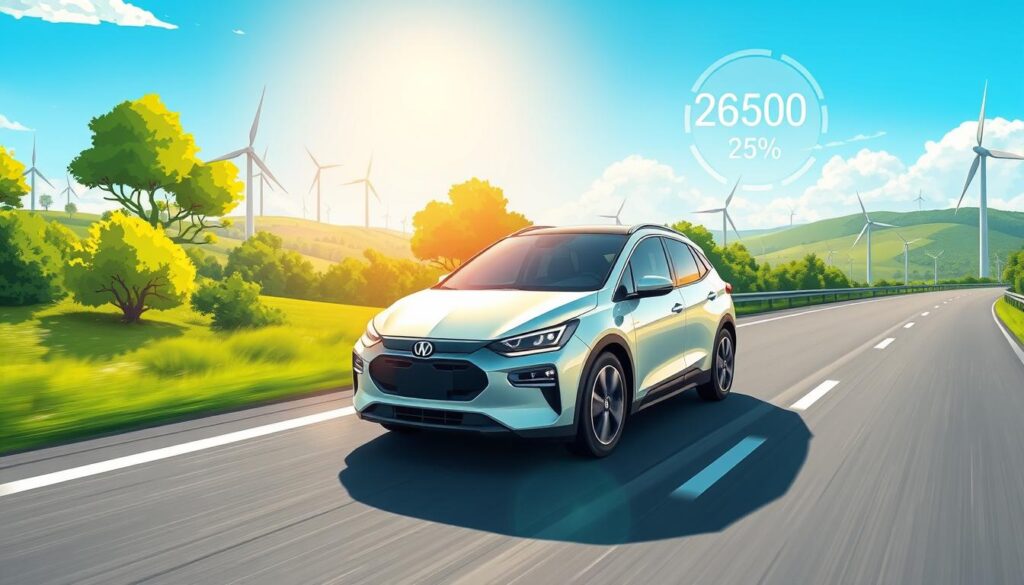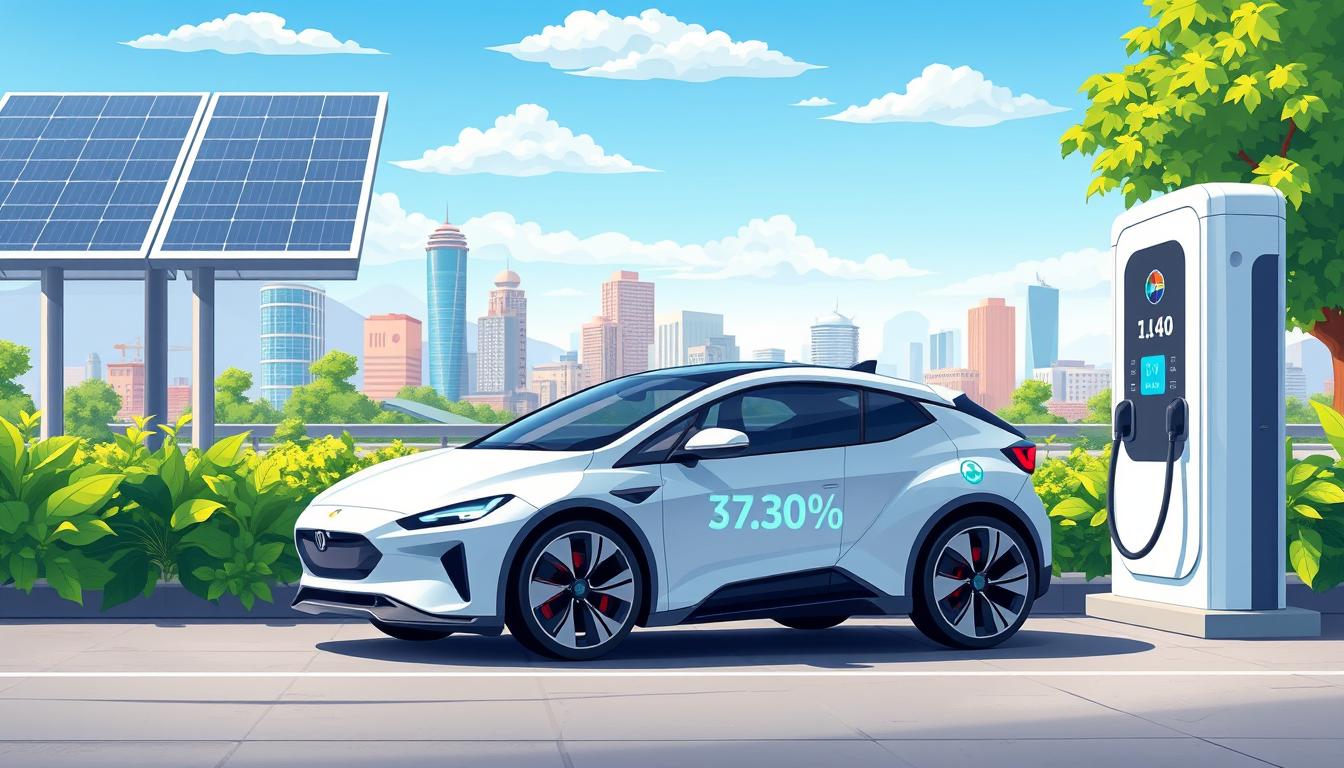With gas prices on the rise, many Americans are looking for ways to save money at the pump. Plug-in hybrid electric vehicles (PHEVs) are a top choice for this. They combine the efficiency of electric power with the range of a traditional gas car. This means big savings on fuel costs that can really help your wallet.
Contents
Key Takeaways
- PHEVs provide significant fuel cost savings compared to conventional gasoline-powered vehicles.
- PHEVs combine the efficiency of electric power with the flexibility of a gas engine, offering the best of both worlds.
- Factors like driving habits, climate, and vehicle features can all impact PHEV fuel economy.
- Choosing the right PHEV model that aligns with your driving needs and budget is crucial.
- PHEVs are generally low-maintenance and cost-effective to operate compared to traditional gas-powered cars.
Benefits of Plug-in Hybrid Vehicles
Substantial Fuel Cost Savings
Choosing a plug-in hybrid electric vehicle (PHEV) can lead to big savings on fuel costs. These vehicles use 30% to 60% less petroleum than traditional cars. This means drivers can save a lot at the pump.
They do this by using both an electric motor and a gasoline engine. This setup lets drivers use electricity for short trips and gas for longer ones.
The initial cost of a PHEV might be higher than other models. But, the savings on fuel over time can offset this cost. Plus, there are federal tax incentives of up to $7,500 for certain PHEVs. This makes them more affordable.
Charging a PHEV at home with a 120-volt outlet takes a few hours. But, using a 240-volt charger or a public charger can cut this time to 1-4 hours. This makes it easy for drivers to charge their cars and get the most out of the electric range.
The electric range of a PHEV can be from 10 to 50 miles per charge. This is much more than the 1-2 miles of traditional hybrids.
PHEVs also have lower maintenance and repair costs. This is because the engine wears out less and the regenerative braking system helps brakes last longer.
| Benefit | Description |
|---|---|
| Fuel Cost Savings | PHEVs can use 30% to 60% less petroleum than conventional vehicles, leading to significant savings at the pump. |
| Tax Incentives | Federal tax incentives of up to $7,500 are available for qualifying PHEV models, reducing the upfront cost. |
| Maintenance Costs | PHEVs typically have lower maintenance and repair expenses due to reduced wear and tear on the engine and brakes. |
“PHEVs can reduce fuel consumption and operating costs relative to conventional vehicles when utilizing electricity from the grid.”
Understanding Plug-in Hybrid Fuel Economy
Plug-in hybrid electric vehicles (PHEVs) combine fuel efficiency with driving convenience. They use both an electric motor and a gasoline engine. This mix gives drivers the best of both worlds. Knowing how PHEVs work helps save money and protect the environment.
PHEVs can run on electric power for short trips before switching to hybrid mode. This system lets them go farther on electricity alone. It cuts down on gasoline use and emissions.
- Using a PHEV on electricity costs less than half as much as gasoline, on average.
- PHEVs have bigger batteries than regular hybrids, letting them drive more on electricity and use less gasoline.
- Some PHEVs can go up to 40 miles on one charge, cutting down on gasoline for daily trips.
- The electric motors in PHEVs let them use electric mode even at high speeds, saving more fuel.
The actual fuel economy and range of PHEVs can change a lot based on how people drive and their surroundings. Things like how far you drive between charges, your driving style, and the roads you take affect how much energy a PHEV uses.
“PHEVs are seen as a key part of automakers’ strategies to adhere to emissions regulations limiting carbon pollution from vehicles.”
As more people buy PHEVs, knowing how they work and how to get the most out of them is important. It helps save money and reduce harm to the environment.

plug in hybrid fuel economy
Plug-in hybrid electric vehicles (PHEVs) are catching the eye of those who care about the planet. They offer great fuel efficiency. These cars give you the electric range of an EV and the long range of a traditional hybrid.
Studies show that top PHEVs are really good at saving fuel. The Toyota Prius Prime can go up to 54 miles per gallon (MPG) just on gasoline. The Honda Accord Plug-in Hybrid is even better, with 46 MPG in hybrid mode. And the BMW X5 xDrive40e, a big SUV, gets 24 MPG on just its engine.
The real highlight of PHEVs is their miles per gallon equivalent (MPGe) rating. This shows how well a car uses energy, counting both electricity and gasoline. Many PHEVs get over 100 MPGe in electric mode, which means big savings on energy costs.
“PHEVs are an increasingly important part of automakers’ strategies to meet emissions rules that cap carbon pollution from cars.”
Now, there are over 30 PHEV models in the U.S. market. This means more choices for buyers. Whether you want the longest electric range, the best efficiency, or a mix of both, you can find a PHEV that fits your needs.
The future of driving is electric, and plug-in hybrids are key to getting there. They combine electric and gasoline power perfectly. This makes them great for saving money on gas and being kind to the planet.
Factors Affecting Plug-in Hybrid Fuel Economy
Driving Habits and Conditions
The fuel economy of plug-in hybrid electric vehicles (PHEVs) can change a lot. This depends on how you drive and the weather. Knowing these things is key to getting the most out of your PHEV and saving money.
How you drive affects your PHEV’s fuel economy a lot. If you speed up a lot, drive fast on the highway, or brake hard, you’ll use more energy. This means you won’t save as much money on fuel.
On the other hand, driving carefully can help your PHEV use less energy. Slowly speeding up and keeping speeds down helps your car work better and save fuel.
Weather can also change how well your PHEV uses fuel. Very hot or cold weather can make your car use more energy. This means it might not run as long on electric power and you’ll use more fuel.
| Factor | Impact on PHEV Fuel Economy |
|---|---|
| Driving Habits | Frequent acceleration, high speeds, and aggressive braking can reduce PHEV efficiency and increase fuel consumption. Sensible driving techniques can enhance performance and improve overall fuel economy. |
| Weather Conditions | Extreme temperatures, both hot and cold, can negatively impact PHEV energy availability and efficiency, leading to higher fuel consumption rates. |
Knowing what affects PHEV fuel economy helps drivers make better choices. This way, they can get the most out of their plug-in hybrids and save money on fuel over time.

“Sensible driving has been proven to save more gas than many drivers anticipate, impacting fuel economy positively.” – Oak Ridge National Laboratory, 2017
Choosing the Right Plug-in Hybrid for Your Needs
There are over 30 PHEV models in the U.S. market now. It’s important to pick the right one for your needs and lifestyle. This choice helps save on fuel and improves your driving experience. I look at the electric range, cargo space, towing capacity, and home charging options when picking a model.
When comparing PHEV models, I think about which one suits my driving habits. If I drive less than 40 miles a day, a PHEV with 20-40 miles of electric range is best. It lets me use electricity more and go to the gas station less. But, if I often tow heavy loads or carry big cargo, I need a PHEV that can handle it.
Charging the PHEV at home is also key. Most PHEVs can charge overnight with a standard 120-volt outlet. But, if you don’t have a charging setup, choose a PHEV with a shorter electric range. This way, you can use the gas engine more.
Source Links
- https://www.fueleconomy.gov/feg/atv-hev.shtml – Where the Energy Goes: Hybrids
- https://www.cartalk.com/car-owning/how-much-can-you-save-on-gas-with-evs-plug-ins-and-hybrid-vehicles – How Much Can You Save on Gas with EVs, Plug-ins, and Hybrid Vehicles – Car Talk
- https://www.fueleconomy.gov/feg/phevtech.shtml – Plug-in Hybrids
- https://www.progressive.com/answers/what-is-plug-in-hybrid-car/ – What is a Plug-In Hybrid Car?
- https://afdc.energy.gov/vehicles/electric-basics-phev – Alternative Fuels Data Center: Plug-In Hybrid Electric Vehicles
- https://www.fueleconomy.gov/feg/transcript-how-plug-in-hybrids-save-money.shtml – How Plug-in Hybrids Save Money
- https://www.consumerreports.org/cars/hybrids-evs/is-a-plug-in-hybrid-vehicle-right-for-you-a9339147016/?srsltid=AfmBOoq_68oMagXSyZbYrt32exEW3iWPYS0N-_69HitoMAj_3uag2fh6 – Is a Plug-In Hybrid Vehicle Right for You? – Consumer Reports
- https://www.consumerreports.org/cars/hybrids-evs/is-a-plug-in-hybrid-vehicle-right-for-you-a9339147016/?srsltid=AfmBOopBDAZDT1c5wY84zNO2yNJYMw-iQ8JfAf7L7tlMmu8L-D5qqgD1 – Is a Plug-In Hybrid Vehicle Right for You? – Consumer Reports
- https://en.wikipedia.org/wiki/Plug-in_hybrid_car_energy_efficiency – Plug-in hybrid car energy efficiency
- https://www.pcmag.com/how-to/what-is-mpge-the-new-fuel-efficiency-rating-for-hybrids-and-evs-explained – What Is MPGe? The New Fuel Efficiency Rating for Hybrids and EVs, Explained
- https://www.fueleconomy.gov/feg/evtips.shtml – Tips for Hybrids, Plug-in Hybrids, and Electric Vehicles
- https://www.autoevolution.com/news/real-world-data-shows-plug-in-hybrid-vehicles-are-less-efficient-than-ices-207406.html – Real-World Data Shows Plug-In Hybrid Vehicles Are Less Efficient Than ICEs
- https://www.consumerreports.org/cars/hybrids-evs/is-a-plug-in-hybrid-vehicle-right-for-you-a9339147016/?srsltid=AfmBOoreBk3uXg4z-4i29nFtbEWnaBoeGzbIPQQAq5gFzh7TYkFYiddr – Is a Plug-In Hybrid Vehicle Right for You? – Consumer Reports
- https://www.autostoday.com/blog/hybrid-vs-plug-in-hybrid – Which Is Right for You?

Hi, I’m Sufiyan, the developer behind this platform. I created FuelConsumptionCalculator.com to simplify fuel tracking for everyone — because understanding your vehicle shouldn’t require a degree in mechanics. I’m always working on adding more tools and content to make this site even more useful

